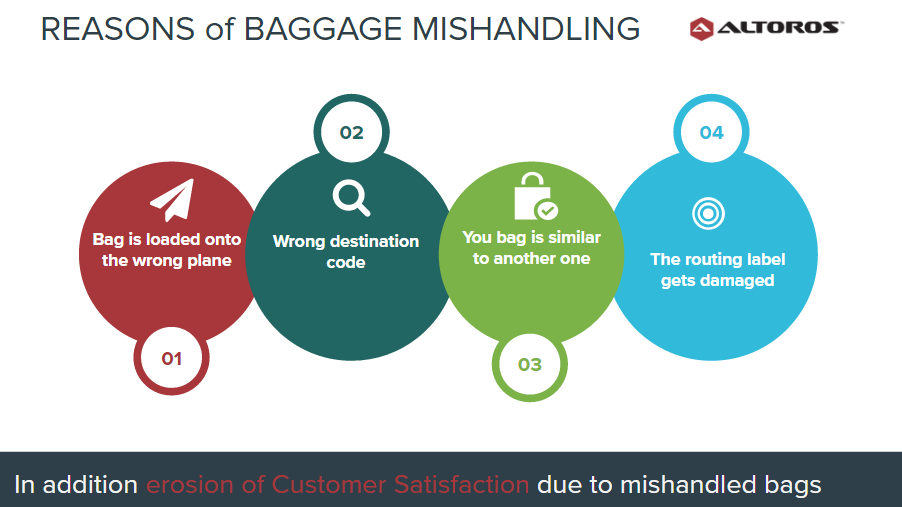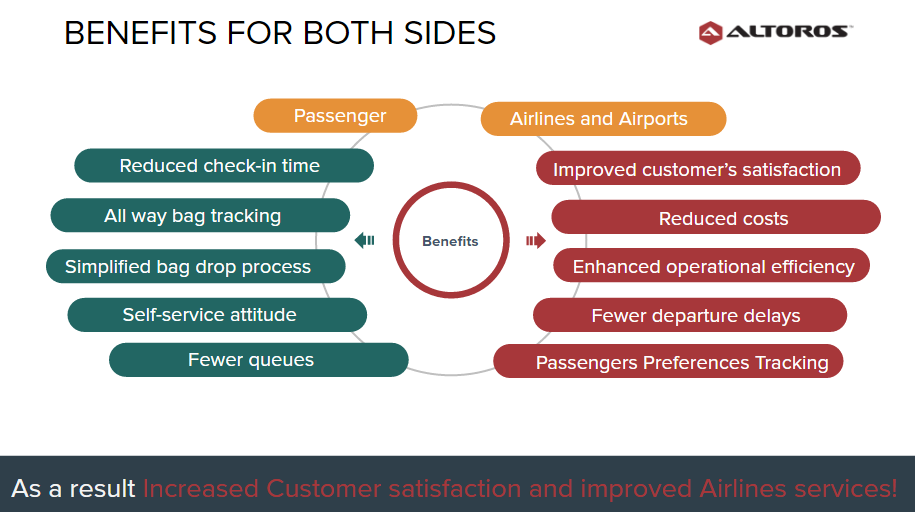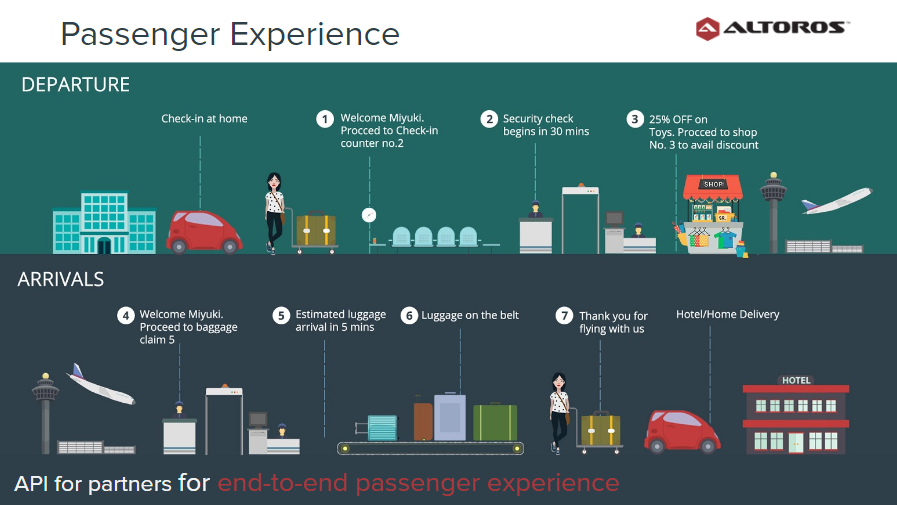IoT for Airlines: Smart Baggage Tracking with RFID and Cloud Foundry
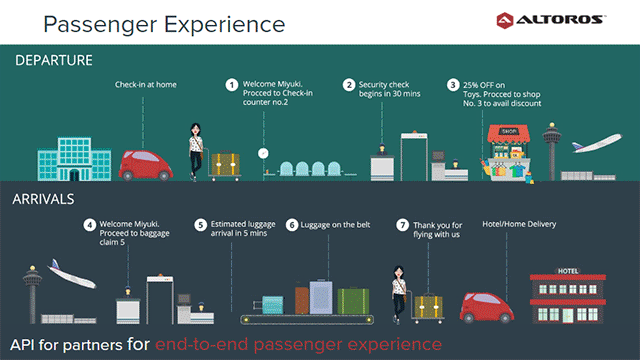
Millions of bags are mishandled by airlines each year, at a cost to the industry of hundreds of millions of dollars and upset customers. Additionally, the International Air Transport Association (IATA)—the trade association for 250 airlines worldwide—is mandating improved baggage handling systems by June 2018 through its Resolution 753.
Now, the use of Industrial Internet of Things (IIoT) initiatives—in which tagged bags are the “things” in the network—are being developed to address this issue.
Why this happens
Here are four common scenarios involving baggage mishandling:
- Your bag is loaded onto the wrong plane.
Cause: You check your bag and, moments after it rides out of view on the conveyor belt, human error steps in. An employee places it on the wrong baggage cart, and it gets loaded onto the wrong plane. - The attendant types in the wrong destination code.
Cause: When you hand over your luggage, the bag-check attendant accidentally inputs the wrong destination code. - You forget to pick up your luggage upon landing.
Cause: Maybe you’re distracted by an urgent text upon landing at home and head straight for a taxi. Maybe you’re weighted down with heavy carry-on bags and forget you checked one more. Whatever the reason, you walk straight past the carousel and leave the airport without collecting your generic black roller bag (with no I.D. tag) and don’t realize it until you’ve arrived to your hotel or home. - The routing label gets damaged.
Cause: When you check your bag, it gets tagged with an oddly printed, illegible routing label—or a legible label gets snagged and torn off your bag shortly after being tagged. Adding insult to injury, it’s a new suitcase and you’ve forgotten to fill in leather-bound identification card.
In addition to that, passengers cite several issues:
- 81% of passengers want to track their bags at any point throughout the journey.
- 48% of passengers want to prevent any agent intervention during bag drop/tag and scan process, and they anticipate time for this actions as 1-3 minutes.
- 74% of passengers would like to be informed about baggage status and delivery waiting time, if there is any.
- 63% of passengers want airlines to improve their baggage handling and tracking process and make it more transparent to passengers.
Delivering a passenger’s bag on time to the appointed place improves customer satisfaction and impacts an airline’s bottom line. In fact, not doing so is the leading cause of passenger complaints, and lack of good information makes the situation worse.

Push notifications and RFID are required
Push notifications are one way to improve service and customer satisfaction. The IATA resolution says they should be implemented when bags are loaded, when they arrive, and in cases where they’re are transferred.
However, a superior implementation could do more than that by welcoming passengers to the airport, providing an estimated baggage arrival time, and thanking passengers for flying with the airline.
Radio-frequency identification (RFID) is an underlying approach to improving existing baggage-handling services and providing new services.
The IATA is in fact calling for the use of the RFID technologies in baggage handling. The organization has participated in RFID trials, developed an industry standard for smart baggage tags and produced a business case for its airline members.
Numerous types of trials around the world show that RFID tags—when coupled with management reporting systems—help to improve baggage performance. Further research shows that airports and passengers benefit through fewer baggage claims, greater handling efficiency, and less journey disruption.
This is leading airlines to standardize their use of modern technologies such as RFID, and thereby create various ways to improve customer satisfaction, and sell additional products and services to passengers throughout their journeys.
Working toward customer satisfaction
Even though passengers can reduce some of these risks themselves by properly tagging their bags, an effective, modern baggage-handling solution obviates this need. Taking care of customer headaches benefits them and increases their satisfaction rate, and smart baggage tracking brings benefits to both sides.
For passengers:
- Reduced check-in time by making this process more digital (website, mobile app, self-service kiosks).
- Informed passengers always know where to go, the location of his/her bag, and what to do if something goes wrong.
- Quick bag drop process without human impact by self-service points.
- Reduce the number of checkpoints and as result fast, smooth, and pleasant passenger journey through all stages.
For airlines and airports:
- Improve customer satisfaction as noted above.
- Reduce costs by decreasing mishandled/lost/damaged bags.
- Enhance operational efficiency by reducing the number of checkpoints, sharing baggage info through all stakeholders.
- Increase performance by self-service check-in and bag drop points.
- Reduce departure delays by tagging bags and exception handling.
- Ability to track passengers and provide them with more additional services and goods.
New opportunities for airlines and airports
In addition, there are many new initiatives, opportunities, and services that airlines can provide their customers by use of new IoT deployments. Some of the top ones are:
- Home pickup and delivery service. Customers drop their bags at home and pick them up at the destination location, whether a hotel, rented apartment, etc.
- Augmented reality. Route customers via a mobile app with augmented reality, showing the way to the gate, to the nearest restaurant, security checkpoint, or any other place at the airport.
- Transfer services. Provide a list of local transportation vendors (taxis, vans, limos, buses, trains) and transportation booking services.
- Boarding times, etc. Notify customers about boarding times, when boarding is closing, and gate changes through apps and sms.
- Lost and Found Service. Integrate Lost and Found service with baggage tracking to inform passenger where is his/her baggage now.
- Personalized promotions. Analyze customer preferences to provide them this service.
- Restaurants and lounges. Analyze a customer’s experience at the airport to be able to provide them with the departure restaurants, lounges, and stores that best suit his/her profile.
- Loyalty programs. Extend the programs to provide the above services as part of different program tiers.
A complete customer experience might look something like the following:
Some current investments
Some major airports and airlines are already investing significant amounts toward improved, end-to-end baggage handling systems and customer experiences:
- Aer Lingus and Ryanair have invested €2 million in 62 new self-service kiosks to streamline and simplify the baggage check-in process for passengers, as well as will reduce check-in queue times and also increase the overall capacity at check-in for all airport terminals.
- London Stansted Airport and the major airlines there recently completed an £80-million redevelopment. As part of the project, the departure lounge floor space was increased by 60%, enabling the introduction of 40 new shops, restaurants, and bars, which are connected to the new augmented reality mobile application.
- One of the airports is creating new spaces that allow new technology to speed passengers through the processing part of their journey. They will help airlines eliminate queues, handle greater numbers of passengers, and put people in charge of how they spend their time at the airport.
- Delta Airlines has made a $50-million investment in RFID at 344 bag drop stations around the globe. The airline now aims at delivering every bag on every flight reliably. This innovative application of technolog gives passengers and other baggage stakeholders greater data and more precise information throughout each bag’s journey.
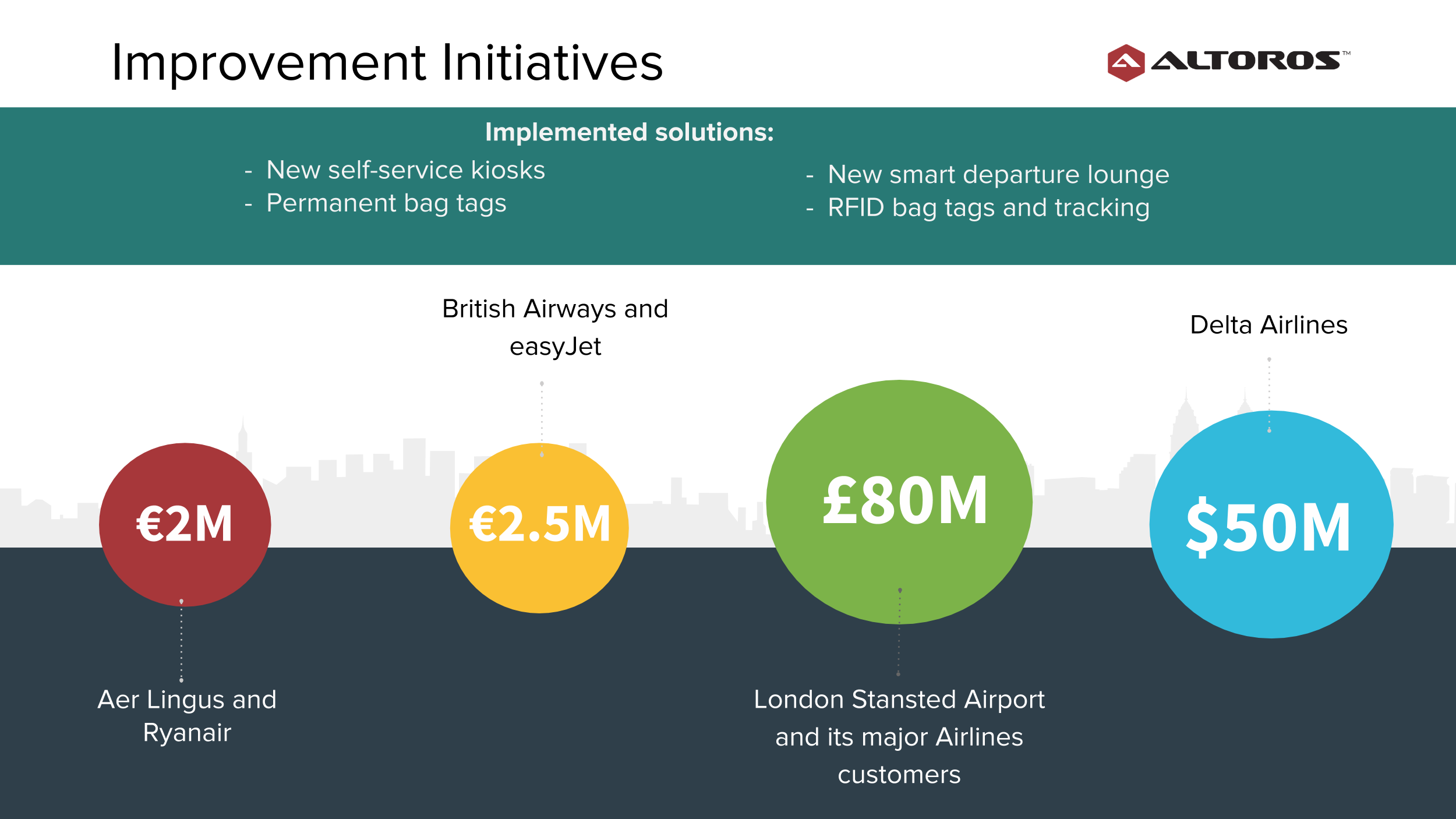
A cloud-native prototype
Altoros has been involved in several initiatives with airlines, so it has picked up some knowledge that can address many issues connected with customer satisfaction improvement. One of the most common initiatives is to connect several processes and systems through the use of IoT technologies.
For baggage tracking, we focused on cloud-native development on top of PaaS solutions. An end-to-end prototype was built with GE’s Predix platform, although we shouldn’t rule out the use of other Cloud Foundry distributions.
Altoros has developed a couple of microservices on top of Predix and APIs for baggage management and personalized customer’s experience in real time. A very generalized view of a proof-of-concept could look like this:
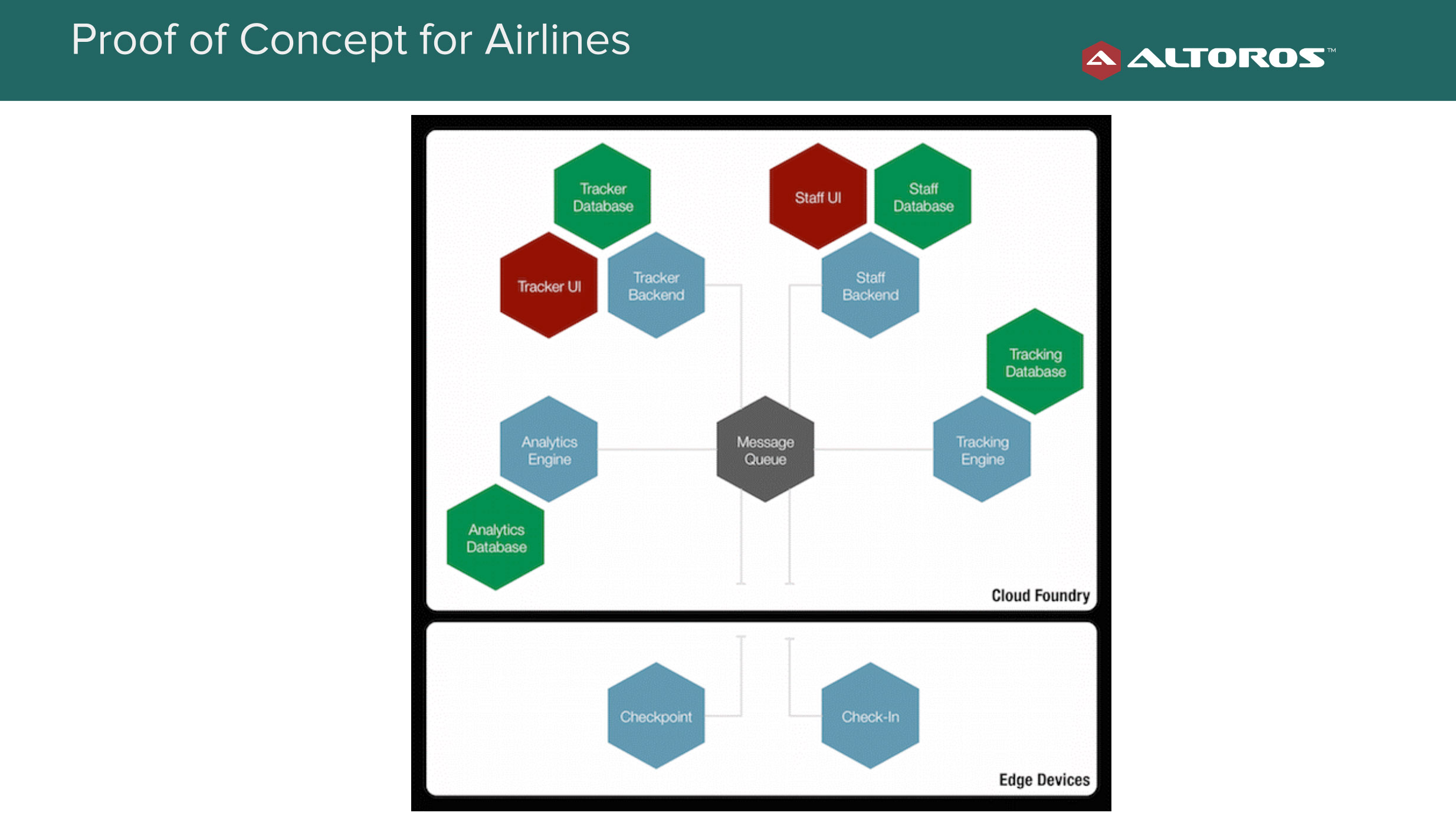
We suggest that to be ready to implement a smart baggage tracking solution, an airline should first assess its current infrastructure and software. From that point, its business and IT teams can find the appropriate technologies (starting with the type of tags and ending with the software design approach).
See it live
The prototype for smart baggage tracking will be demonstrated at the Cloud Foundry Summit in Frankfurt, Germany, on September 28, 2016. Presenters are Elena Travkina from Altoros and Shyam Varan Nath from GE Digital.
For more details, you can also watch the recording from the webinar on the topic. If you want to deploy a prototype in just 48 hours, feel free to contact us for assistance.
Want details? Watch the videos!
These are the slides presented by Elena Travkina and Shyam Varan Nath.
This blog post was written by Roger Strukhoff and Sergey Yaroshko,
edited by Alex Khizhniak and Sophie Turol.



